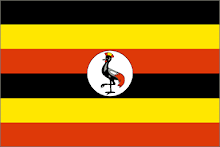Leaving the city center along Kira Road, as business establishments begin to give way to street vendors and huts, you come to a roundabout that sends strips of tarmac shooting in all directions. The hub of a paved wheel, four roads run from the roundabout like spokes to the western rim of the country.
If you aren’t paying attention as you approach, you will miss the inconspicuous building hiding behind a row of trees on the left, its façade giving no indication as to the nature of business within. It is the Kira Road Police Station.
If you do manage to pull off before the roundabout, you’ll find the dirt parking lot outside the station a confused mess of cars and motorcycles parked in every direction, some appearing to have taken permanent residence among the patches of weeds and potholes. The arrangement is consistent with the business inside.
At the front desk of the station, the ordered chaos of officers leading shackled prisoners to unknown chambers mixes with the clang and rattle of detainees in their holding cells. Some victims and family members hoping to file complaints sit on wood benches while others clamor for the ear of an officer. The sound is a jumble of rattling metal, English, Luganda, and various dialects, all creating an indiscernible din.
Our host quickly ushers us past the front desk where more arrestees awaiting processing sit on the cement floor. Some sleep while others look up as we pass through the back door of the station into the dirt courtyard.
Outside, the courtyard is a peninsula, surrounded on three sides by the U-shaped station. Two eight-foot tall aluminum cylinders with cone roofs bake in the sun; neither of the three walls of the U provide the cylinders shade. The foul smell of human waste stagnates and arms reach through the barred windows of each cylinder.
They are holding cells, no more than twenty feet in diameter, temporary home to women charged with crimes, but whose immediate fate has yet been decided. The heat of the sweltering midday sun pours off the aluminum roofs.
By law detainees cannot remain in these cells for more than 48 hours, we are told with a wink and smile.
A stairwell along one side of the U leads up to the offices for the OCCID, Officer in Charge of Criminal Investigations Division, and the Divisional Police Commander. From the second floor, you can see over a fence the barracks for officers in the Kira department. The barracks are comprised of row houses and more cylinders like the holding cells for the women.
We are told that to each dwelling two officers and their families are assigned, some cylinders housing as many as fourteen people. At a salary of $75 a month, the free housing is a perk available to officers, one that most take advantage of. Of course, the salary has another indicator. At less than $3 a day, it is not difficult to understand why police officers are frequently linked to corruption in the form of bribery.
A young woman with whom I work at the courthouse recently told me a story of foreigners she knew. The Americans, a couple, had been seen kissing in public by an officer. Told that it was illegal, the officer successfully extorted from them 60,000 Ugandan shillings (about $30 U.S.) in exchange for not being arrested. This thought is firm in my mind as the officer leading us to the OC’s office announces us to him.
The Officer in Charge wears a suit and is intently listening to a briefing as we enter. In the corner, a uniformed officer is addressing the OC, but I can’t make it out through his thick accent.
On the couch opposite the OC’s desk is a child no older than twelve. With short hair and soft features, the dress she wears is the best indicator that it is a young girl. A young man, perhaps eighteen, sits on the floor. His shirt is tattered and his grimy pants are rolled up to his shins, exposing his bare, worn feet.
We stand listening to the officer wrap up his briefing. The OC asks something about HIV. The officer responds, “No.”
The OC indicates that the girl should be taken to her parents, the young man sent home. At this, the officer stands and crisply salutes the OC. He then collects the girl and boy and leads them out of the office.
During our subsequent meeting with the OC, we are told that the officer will complete his investigation prior to charges being brought in the case. We learn that the girl is an alleged rape victim. The young man, the accused. The briefing we heard was the officer’s preliminary findings based on interviews with the boy and the girl. He presented it in front of them. As they sat in the same room together. An arm’s reach apart.
As the wheels of justice turn, this is the first step in a lengthy, sometimes years-long process that will result either in the young man going free or in a conviction that could carry the death sentence.
Friday, July 10, 2009
Subscribe to:
Post Comments (Atom)

No comments:
Post a Comment